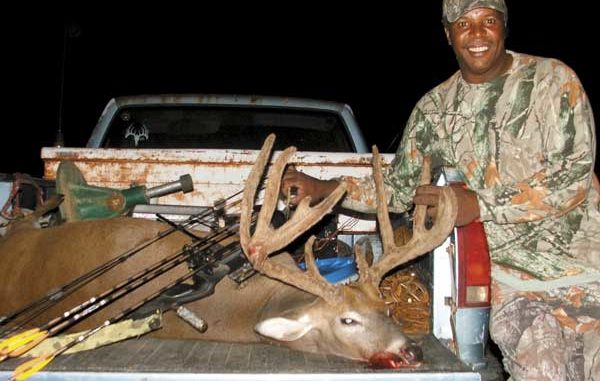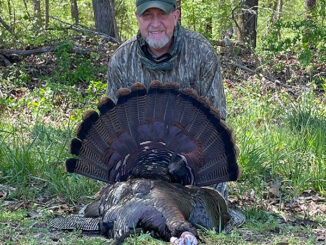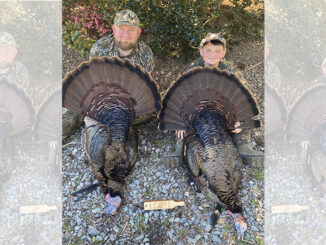
This Durham hunter bagged his second-straight trophy, this time with a bow.
Northern Durham and southern Person counties have had a reputation for years as areas that produce some of North Carolina’s most-impressive trophy deer.
The Timberlake region in Person, just across the Durham County line, was where Don Rockett of Hickory downed the state-record non-typical, a 228 4/8-inches monster in 1998. Two years earlier Stuart Gentry claimed the previous non-typical record with a 209 2/8-inches buck.
Rickey Glenn, 49, of Durham, who works for the city’s street maintenance department, kept the region’s big-buck reputation alive September 18 when he arrowed a massive in-velvet 10-point buck near Rougemont.
And it was the second-straight year that Glenn had taken a noteworthy buck from this area. Last year he was hunting November 25 with his two sons when he downed a non-typical main-frame eight-pointer that had 153 6/8 inches of non-typical antlers and scored 147 6/8 as a typical.
But his 2006 feat was done by jump-shooting the buck with a shotgun while walking near a thicket in a field with his two sons.
“I’d gotten off work and shod a couple of horses for my sister,” said Glenn, “and when I went to put the horse up, I saw a doe coming across a pasture near a fence line. That got me to thinking a buck might be in the area. I knew (bucks) shouldn’t be chasing does yet, but you never know the way the weather has been around here if bucks already were starting to chase some does.”
Glenn hurried to his sister’s house where he keeps his hunting clothes, archery equipment and guns and quickly donned his light-brown-and-green leaf-colored camouflage hunting clothes, then grabbed an ancient compound bow.
“It’s a Darton bow, a compound with hardly no let-off,” he said. “When I pull it back, I have to put the bow in front of me and pull it back, then I raise the arrow (knock) to my mouth. I also have really long arrows, so long they don’t even cut off (the ends) before they glue the screw-ins for the broadheads.”
He uses Thunderhead fixed three-bladed broadheads along with a newer Lightning variety.
Glenn quickly hurried to the old fence line that extended from the pasture into some woods near his sister’s house and picked out a white oak tree then set up his Gorilla climbing stand and began to ascend the oak.
But he didn’t get far.
“I don’t know if it was the same doe I’d seen earlier when I was shoeing the horses, but I was only about 13 feet up that tree when here came a doe down the fence line in the woods,” Glenn said. “She caught me, had me dead to rights.”
Glenn, whose stand was about 20 feet from the fence, waited until the doe passed his location before pulling up his bow with a rope. He’d already decided this was no time to be climbing higher in the tree stand. If deer were moving, he wanted to be ready when the time came and if a buck appeared.
And he knew the area was home to a really impressive whitetail.
“I’d seen him last year before the season came in,” he said. “He was hanging out with ‘Blade,’ the big 10-pointer I killed with the shotgun after my sons, Hunter and Carson, had come home from college at Thanksgiving. He hung out with Blade until the rut began, then they split up. Then they got back together after the rut ended. I don’t have any way to know, but I suspect they may be brothers.
“When ‘Blade’ jumped up in front of me last year at that briar patch last November, I didn’t know which buck it was — ‘Blade’ or this buck, which was an eight-pointer last year.”
One major reason Glenn had chosen this tree stand location was because of the state’s seemingly endless drought. Central North Carolina had been caught in a severe lack of rain situation the entire summer and most of the fall, with precipitation levels almost 20 inches below normal.
Many lakes, ponds and streams in the Piedmont saw drastic falls in water levels. By September, numbers of small streams and creeks that normally provided water for deer and other creatures had become rock-stream passageways, meandering through woods and fields, with grass and weeds growing in them — or simply filled with dust.
“The water situation was one of the reasons I put the stand where I did,” Glenn said. “I had these deer kind of patterned. To get water, they had to either go to the Flat River (several few miles to the north) or come to a pond that was behind my sister’s house. The fence line led directly to that pond. The pond was 200 yards from my stand.”
Another reason he chose the oak tree in the woods near the fence line was local oaks already were dropping acorns, including white oak acorns that are highly favored by deer.
The third and perhaps most important factor that day was wind direction. Glenn’s tree stand was on the east side of the fence, and the wind was blowing from the west.
“The wind was blowing right to me, so if a deer walked that fence line that day, he couldn’t smell me,” he said.
Wisely, he’d switched the seat on his Gorilla stand so he was facing the tree, with the trunk between him and the fence. Basically, the tree trunk provided some sorely-needed cover for Glenn because he was only 13 feet off the ground and had no limbs or leaves to provide natural camouflage.
Glenn said he had no more than put his right foot down in the stand when he spied a six-point buck.
“He stopped about 70 yards from me,” he said, “then he looked behind him and went to smelling the air. He kept coming toward me and that’s when I saw something moving behind him, about 20 yards behind him.
“It was another buck, right on the edge of the pasture.”
Glenn said it seemed like he waited forever for the two bucks to make their way closer to him, advancing slowly down the fence line.
The wait didn’t do his nerves much good, either.
“There were a few acorns falling, so they were taking their time, picking at the acorns and moving toward me, actually probably headed for the pond,” he said.
It was about 6:30 p.m. but because it was the middle of September, Glenn knew something likely would happen before daylight faded.
“The big buck was facing right at me, but he was on the other side of the tree,” Glenn said. “It’s a wonder he didn’t hear the arrow bouncing on the rest because I know my heart was jumping.”
Glenn said he’d been so fixated on watching the two bucks he didn’t notice a doe that had slipped underneath the oak tree to nibble acorns. But she must have gotten nervous because she suddenly bolted away.
“I was afraid she might have smelled me, but the wind was right, and I was trying to be as still as I could,” he said. “I also was afraid the bucks might follow after her, but they didn’t.”
The hunter said he must have moved a little because the six-point buck “looked right at me but he didn’t see me.
“That’s when the 10-pointer ran right at the six-pointer and ran him off,” Glenn said.
At that point, the big buck was within close bow range. But the deer was facing Glenn’s tree and didn’t present a good target at first.
“It took him 10 minutes to turn broadside,” Glenn said. “That was nerve-wracking. It’s a wonder he didn’t hear the grip (on his bow) popping because I know I was squeezing that thing as hard as I could.
“The good thing was he was on the other side of the tree from me. If I’d been on the same side, he would have seen me for sure.”
The buck, which had been walking from Glenn’s right, finally turned and presented a broadside shot at about 15 yards. Glenn said the buck was too big to not make a good shot so he was going to wait until he got as perfect an angle as he could.
“I put the sight pin on his right shoulder and made a good shot,” Glenn said. “It double-lunged him with no trouble because I was only 13 feet off the ground.”
When he found the buck later, the entrance and exit wounds were almost aligned, Glenn said.
“I was shooting vanes (plastic fletchings), and the arrow went through (the buck) and came out at his left shoulder,” Glenn said. “When he ran off, I could see the arrow hanging out of his left shoulder where the vanes had stopped.”
The big buck bolted away in the direction of the pond after the shot, but Glenn said he
wasn’t worried about losing the deer.
“I knew I’d made a good shot,” he said. “I listened to him run off, then it got quiet. I said, ‘Well, you can’t go far, not hit that good.’ ”
One piece of equipment Glenn didn’t have was a flashlight and by now, in the gathering dusk, he knew he needed some artificial light.
“I walked up to my sister’s house and told her, ‘Well, I got him,’ ” Glenn said. “She said, ‘The big one?’ I nodded my head.”
They both walked to the field then to Glenn’s stand in the woods near the fence line.
“She held the flashlight and we started walking down the fence line,” Glenn said.
Within a few feet, Glenn found where the buck had tried to go through the fence, but couldn’t do it. He and his sister walked a little farther and found the buck, headed for the pond and water.
“He ran probably 120 yards,” Glenn said. “It actually was pretty easy to find him. My sister was shining the light (down the fence line), and I saw his rack sticking up.”
Glenn said the buck weighed more than 200 pounds on the hoof.
“I tried to grab him by the antlers to drag him, but I
couldn’t,” he said. “The velvet started to came off in my hands when I took hold of his rack. (The velvet) would split if you tried to pull him. What’s odd was the six-pointer’s rack was clean; it didn’t have velvet. I guess that’s just the difference in individual deer.”
After Glenn finally got the buck loaded into his truck, he took the animal to Durham taxidermist Mike Renn.
Glenn’s trophy had 25-inch-long main beams, short brow tines of 3 inches in length, but G2s (second tines of each main beam) of 13 inches and G3s of 10 inches.
“He’s 19 inches wide inside and 21 inches wide outside,” Glenn said.
Although in-velvet bucks can’t be officially recorded in the Boone-and-Crockett record book, Renn calculated the buck scores roughly 154 inches as a non-typical.
“I’ve killed one velvet buck in the past,” Glenn said. “But this one is my best one. The rack has a lot of mass, too.”
Last year one of Glenn’s friends was hunting the Blade buck, and Glenn knew his bow-killed September deer was hanging out with Blade during 2006.
“It was hard to keep the secret that there was another real good buck in that area,” Glenn said. “I was just hoping nobody else would see him last year so I’d get a chance at him this year.
“I was lucky to get a chance at him before anyone else, lucky the other deer didn’t see me and lucky to make a shot that put him down.”





Be the first to comment